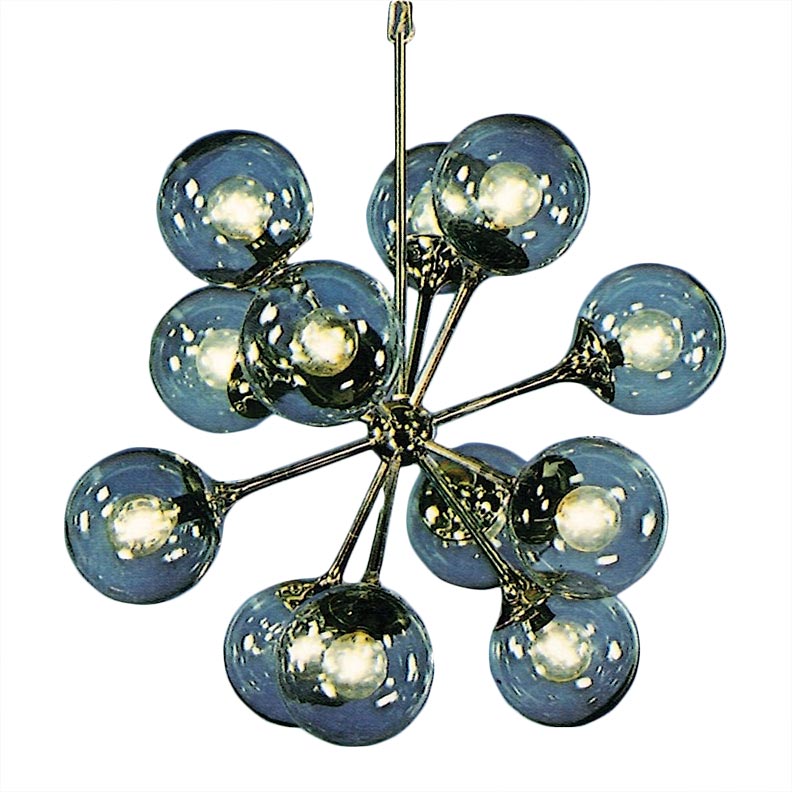Rococo, 1860-1865
Design DNA: Mixed a romantic embrace of nature and European tastes for Baroque revival
Character: Elegantly detailed transition from oil-burning forms to gas and kerosene
Materials: Richly modeled brass castings, etched and cut glass shades
Features: Entwined leaves on chains and decorative arms, font-like central bodies
Fueled By: Rise of the brass industry and the influence of Italianate architecture
Key Cultural Developments: Kerosene introduced in 1859, Civil War envelops the country
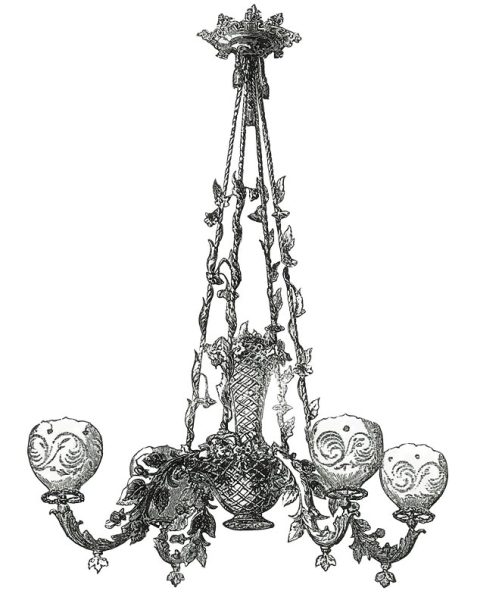
Renaissance Revival, 1865-1870
Design DNA: An eclectic and liberal reimagining of Renaissance design motifs and themes
Character: Highly elaborate fixtures with substantial presence and rich materials
Materials: Mixture of brass, bronze, and spelter (zinc) castings; gilt and painted finishes
Features: Heavy ornamental castings, figural motifs or statuettes of people and animals
Fueled By: Rising wealth and Reconstruction aspirations following the Civil War
Key Cultural Developments: Renaissance Revival influences ran deeply through architecture and décor
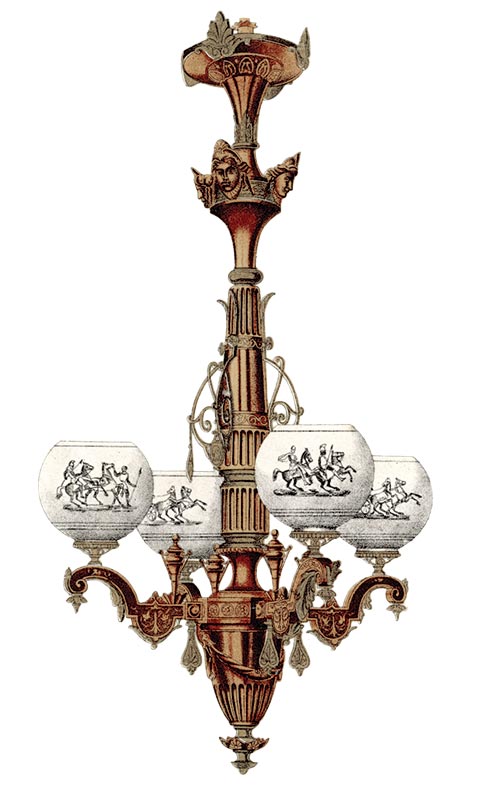
Neo-Grec, 1870-1875
Design DNA: Simpler, cleaner qualities, as seen in Greek to Renaissance architecture
Character: More restrained and angular continuation of earlier elaborate ornamentation
Materials: The height of the mix of bronze and spelter castings, gilt and painted finishes
Features: Distinctive fine scrolling motifs covered flat cast surfaces, small-neck gas shades
Fueled By: Growth of industry and accumulating wealth following Reconstruction
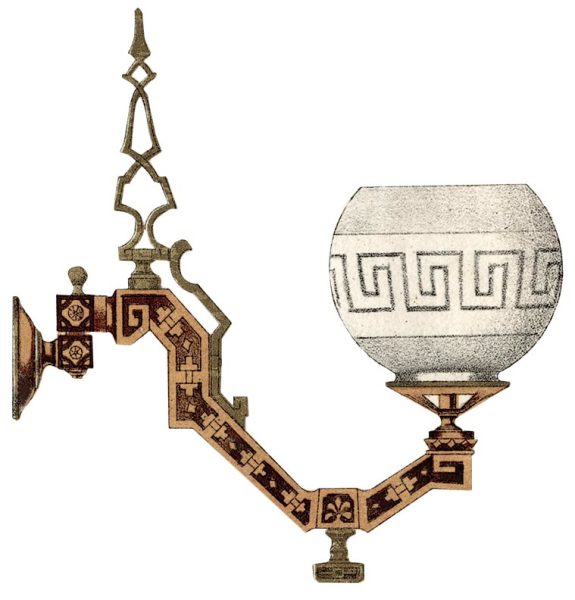
Eastlake/Neo-Gothic, 1875-1880
Design DNA: Rooted deeply in reinterpretations of English medieval and Gothic themes
Character: Restrained compared to Neo-Grec, conventionalized English Neo-Gothic forms
Materials: Shift away from spelter and into more brass and bronze, new polychrome colors
Features: Noticeable incising and flattening of design elements, cleaner “modern” lines
Fueled By: “Liberal” expressions of Englishman Charles Locke Eastlake’s design principles
Key Cultural Developments: Huge impact of 1876 Centennial Exposition and rise of ecclesiastical architecture
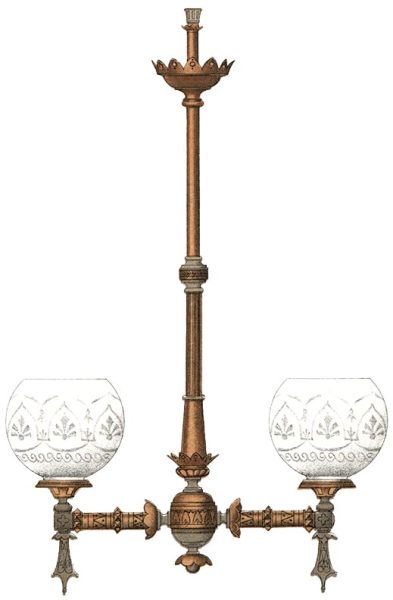
Aesthetic Movement, 1880-1885
Design DNA: Profoundly influenced by Japanese design and the believe in “art for art’s sake”
Character: Bold, angular lines with striking asymmetry, mixed materials, ahistorical
Materials: Predominantly red brass and bronze, Longwy or Satsuma porcelain inserts
Features: Flat conventionalized flower castings, hammered textures, insects, cut jewels
Fueled By: “Artistic” design trend and the craze for all things Japanesque and exotic
Key Cultural Developments: Early exploration of electric fixtures, introduction of wide-neck gas shades
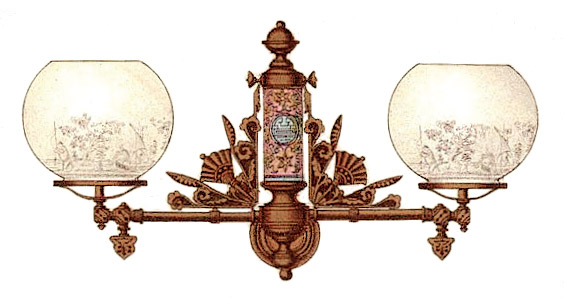
Bent Brass, 1885-1890
Design DNA: A “modernized” hybrid of medieval simplicity and Aesthetic artistic tendencies
Character: Substance and decoration rely more on scrolling effects and sculptural forms
Materials: Richly finished brass or black hand-wrought iron, opalescent and colored glass
Features: Pre-Art Nouveau proliferation of spirals and whips and elegant bent brass tubing
Fueled By: Rise in popularity of Romanesque architecture of H.H. Richardson and others
Key Cultural Developments: Tail end of the great Aesthetic Gilded Age mansions and picturesque effects
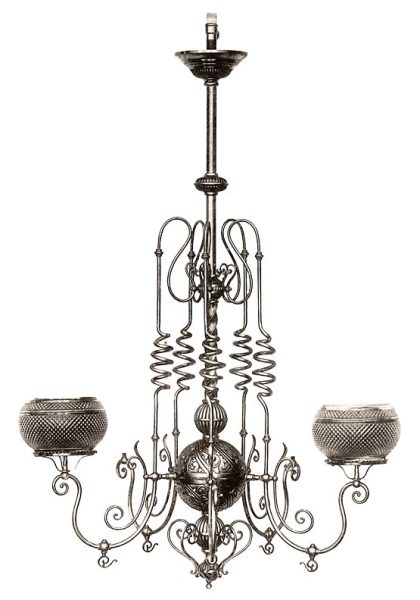
Empire, 1890-1895
Design DNA: Ostensibly a revival of French Empire design (think Josephine and Napoleon)
Character: Return to elaborate and delicate ornamentation—quintessential “Victorian”
Materials: Cast polished brass defines this style, with darker antique copper rising later
Features: Finely filigreed pierced castings with wreaths, ribbons, torches, and garlands
Fueled By: A move toward historical styles and the rise of feminine purchasing power in the home
Key Cultural Developments: Elaborate Victorian design would fall into decline after the Panic of 1893
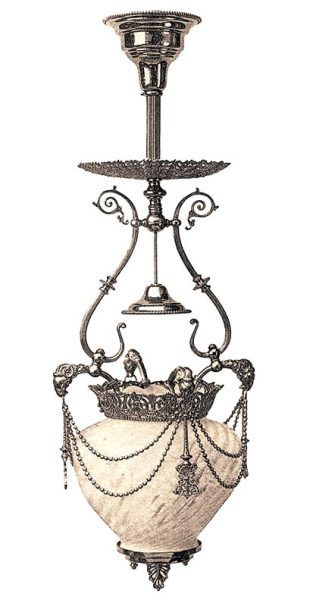
Eclectic Revivals, 1895-1900
Design DNA: New inspiration drawn from historical styles following Chicago World’s Fair in 1893
Character: Heavier reliance on traditional styles, still expressed in familiar Victorian forms
Materials: Fixtures almost entirely brass, using a wide range of manufacturing methods
Features: Cost-cutting resulted in simplified silhouettes, thinner castings, more spinnings
Fueled By: Slow economic recovery, diverse architectural styles, affordable electric lamps
Key Cultural Developments: The 1893 Columbian Exposition initiated a return to symmetrical classical design
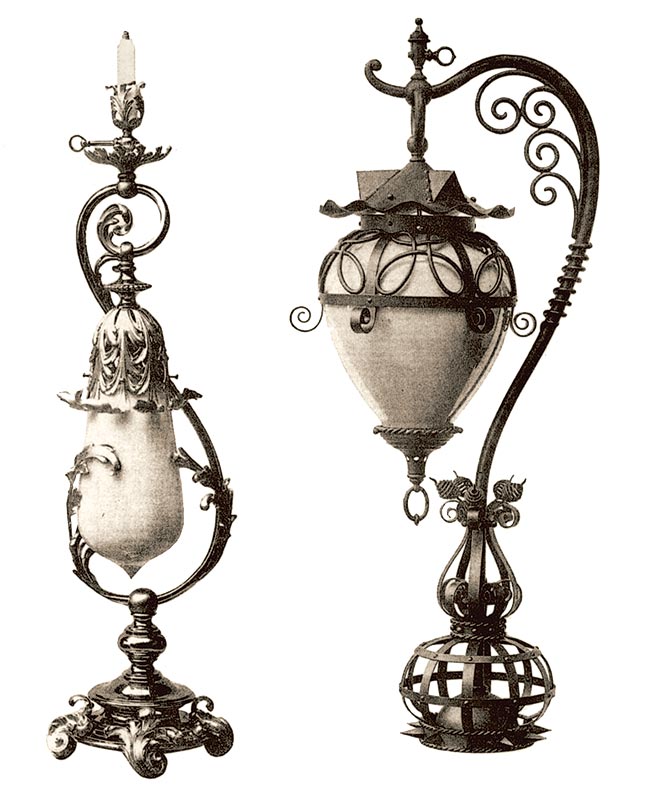
Schools of Design, 1900-1905
Design DNA: More academic yet artful embrace of a broad range of authentic period styles
Character: Bold, transitional, and experimental, moving away from “Victorian” stem & pipe
Materials: Brass in full array of techniques, some wrought iron, art glass and bent glass
Features: Highly architectural in style/detail, detailed castings, gas/electric combinations
Fueled By: Popularity of accurate historical architecture styles, coordination with hardware
Key Cultural Developments: Extensive expansion of commercial, institutional, and ecclesiastical buildings
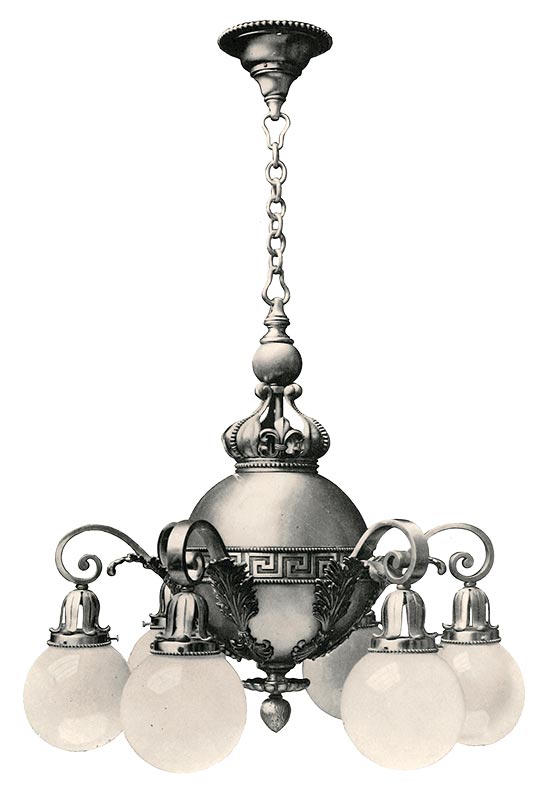
Arts & Crafts, 1905-1910
Design DNA: English Arts & Crafts movement, medieval style, handmade construction
Character: Emphasis on new “modern” forms, celebrating the craft and hand of the maker
Materials: Brass and copper, often hammered or hand-formed and -riveted, leaded glass
Features: Often very “square” forms, art glass panels, brushed brass, dining room “domes”
Fueled By: Arts & Crafts proponents like Elbert Hubbard, Gustav Stickley, and Frank Lloyd Wright
Key Cultural Developments: Stickley’s The Craftsman magazine, return to nature, DIY and spread of bungalows

Classical Revival, 1910-1915
Design DNA: Pendulum swing back to architecturally familiar classical forms and motifs
Character: Substantial, formal, conservative, projecting power and permanence
Materials: Quality brass castings and spinnings, blown and pressed molded glass shades
Features: New “shower” fixtures and bowl chandeliers become extremely popular
Fueled By: Interrelated rise of the affordable Mazda B tungsten lamp and bowl fixtures
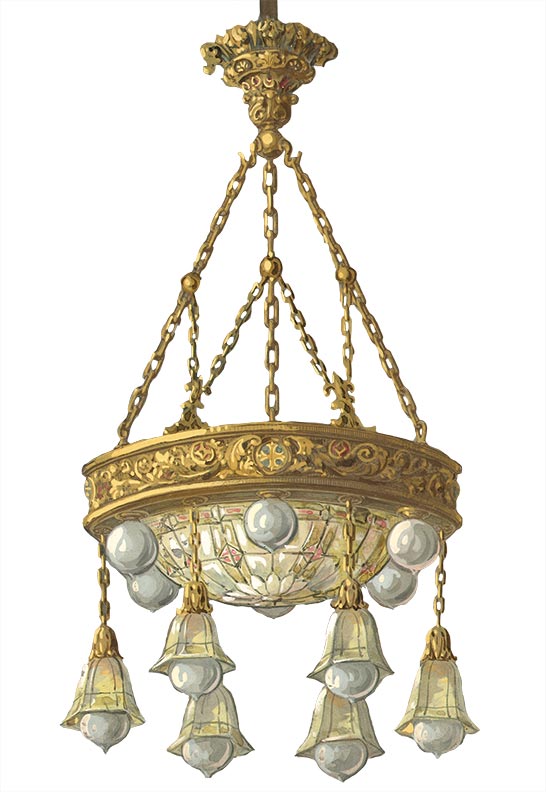
Colonial Revival, 1915-1920
Design DNA: Heavily influenced by interpretations of Georgian-era design, itself very classical
Character: Formal and conservative like Classical Revival, but more elegantly restrained, delicate
Materials: Brass, brass, and more brass, with crystals and cut glass shades to add sparkle
Features: Chains, candles, tassels, garlands, and painted molded satin opal glass shades
Fueled By: Growing provincial self-esteem and the influential work of Wallace Nutting
Key Cultural Developments: America rises to prominence during World War I, stoking national pride
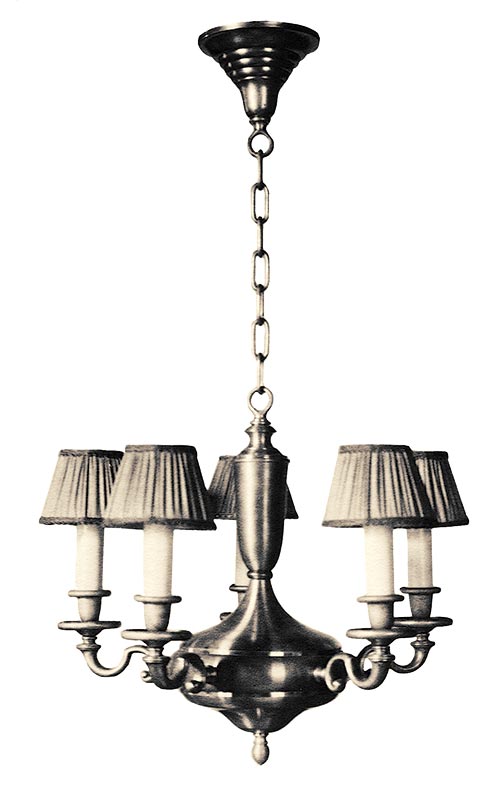
Conventionalized Colonial, 1920-1925
Design DNA: Perhaps the highest point in America’s long-running revivals of the colonial era
Character: A less academic and more safe and standardized version of Colonial Revival
Materials: Brass, with cheaper steel versions offered disguised by popular painted finishes
Features: “Pan” fixtures dominate the market, with candles, down-shades, exposed bulbs
Fueled By: Building boom as cities grew and expanded into the new automobile suburbs
Key Cultural Developments: American pride, national identity and manufacturing growth after World War I
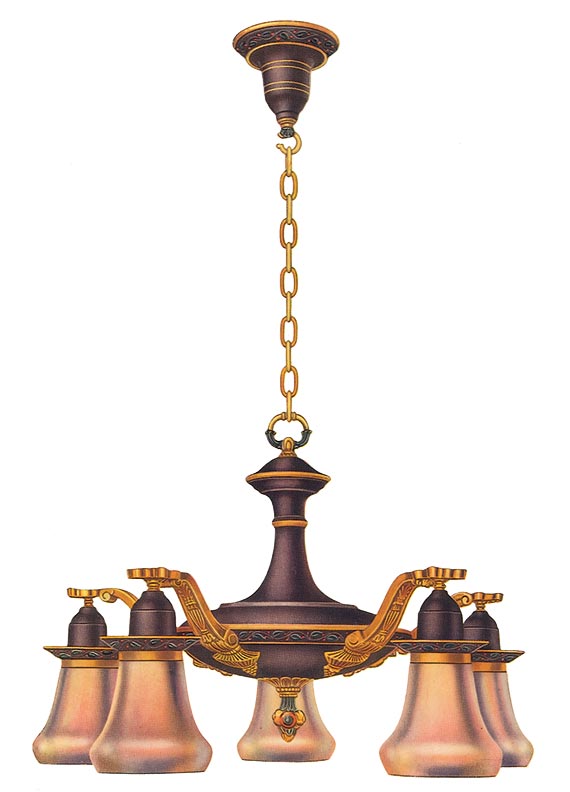
Romantic Revival/Mediterranean, 1925-1930
Design DNA: Romantic interpretations of rustic European “Old World” styles and motifs
Character: Extremely ornate chain-hung fixtures with filigree and scrolling lines
Materials: Intricate cast white metal, elaborate stamped or wrought iron, colored crystals
Features: Colorful polychrome finishes, candles, shields, caravels, tipless globe bulbs
Fueled By: Influence of new exposure and access to Europe following World War I
Key Cultural Developments: The rise of Hollywood, with exotic theaters and swashbuckling movie heroes
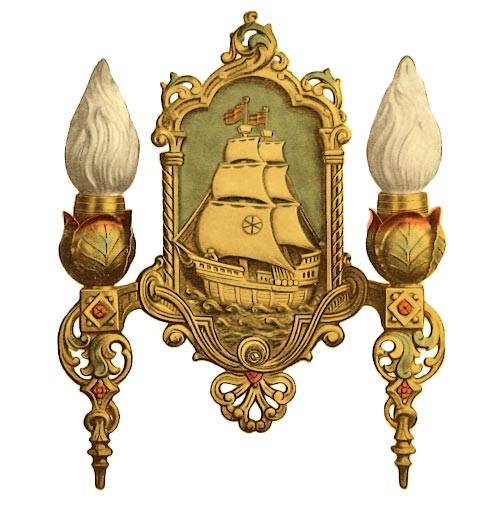
Art Deco, 1930-1935
Design DNA: “Modernistic” design, introduced at the 1925 Paris International Exposition
Character: Complete rejection of historical styles as design inspiration, angular and bold
Materials: Gilt polychrome cast iron/aluminum, Bakelite, chrome, tinted glass shades
Features: The heyday of the “shaded light” and the liberal use of color and decoration
Fueled By: French modern design of 1925, which would not sweep the American market until 1930
Key Cultural Developments: This explosion of new style occurred at the same time as the Great Depression
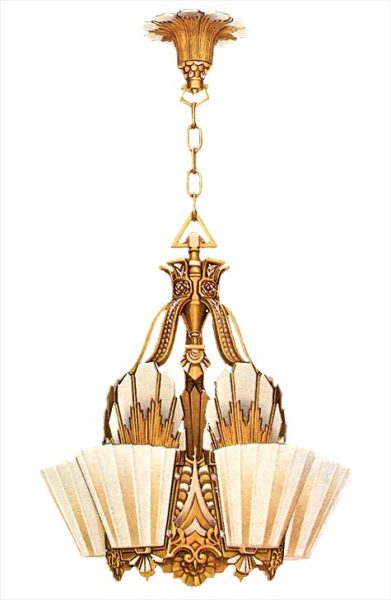
Streamline Moderne, 1935-1940
Design DNA: The true arrival of Modern style, as ornamentation is rejected along with history
Character: Sleek, aerodynamic, streamlined, and quintessentially Modern clean lines
Materials: Aluminum and steel, especially in large spinnings, milk and custard glass
Features: Concentric rings, louvers, bead-chain shades, slip-on cup or saucer shades
Fueled By: The cult of speed expressed through planes, trains, ships, cars, and zeppelins
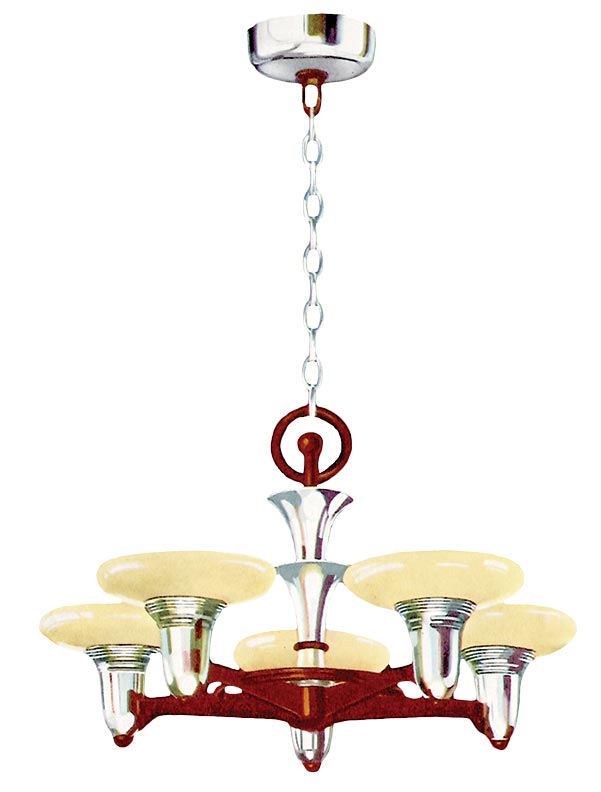
War Era, 1940-1945
Design DNA: Lighting fixture design goes into deep hibernation during World War II
Character: What little lighting is produced follows late 1930s forms but in cheaper materials
Materials: Brass/copper/aluminum/steel rationing results in more solid glass components
Features: All-glass elements like canopies and center bodies, earliest fluorescent fixtures
Fueled By: Fixture advances are mainly industrial as factories and war installations are built
Key Cultural Developments: Fluorescent lighting introduced at 1939 New York and San Francisco World’s Fairs
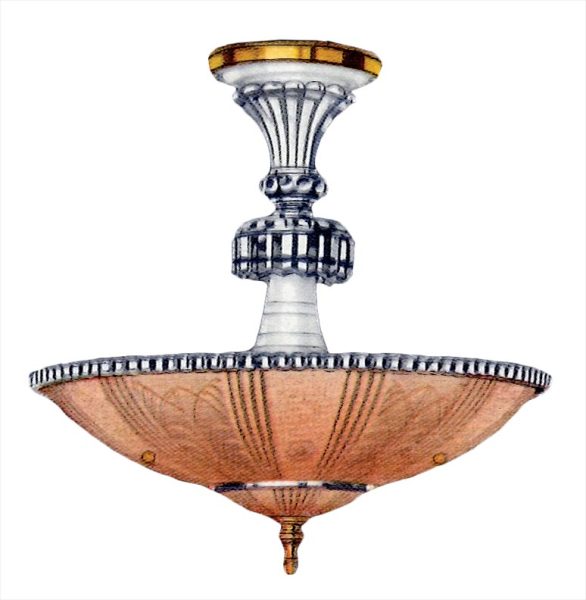
Postwar, 1945-1950
Design DNA: New war machinery in factories and scrapping of old tooling breaks traditions
Character: Industrial outputs slowly shift to domestic with humble, familiar forms
Materials: Steel and aluminum war materials and methods determine domestic direction
Features: Transitional and non-challenging design is frequently forgettable, lots of glass
Fueled By: Slow national economic recovery and retooling for domestic production
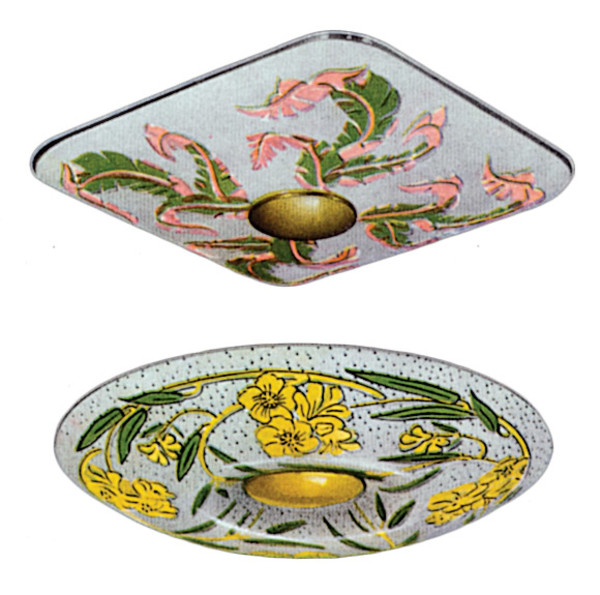
Proto-Modern/Themed, 1950-1955
Design DNA: New “All-American” identity inspires proto-modern colonial hybrid, kids’ fixtures
Character: Hints at early Modern design appear, often awkwardly expressed in mixed forms
Materials: Brass, steel, and aluminum predominate in economical manufacturing methods
Features: Populist “themed” fixtures, painted color, and ubiquitous bent glass shades
Fueled By: American optimism, domestic recovery, and desire to return to normalcy
Key Cultural Developments: The explosion of television projected new stories of American homes/families
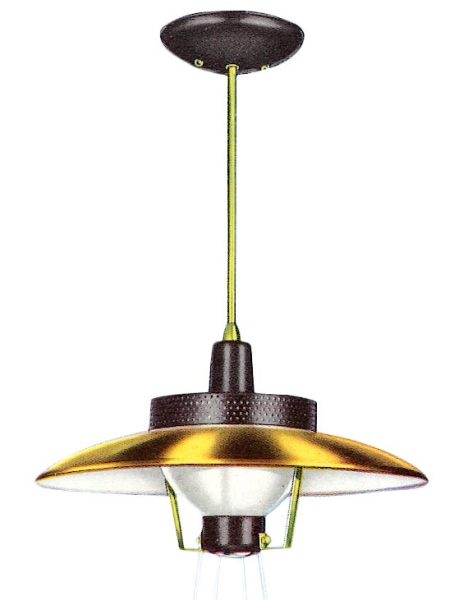
Mid-Century Modern, 1955-1960
Design DNA: American Modern designs often followed Scandinavian and European examples
Character: Sleek and classically “Modern” with jet- and space-inspired silhouettes
Materials: Brass, steel, and aluminum spinnings; early plastic; wood and natural materials
Features: “Starlight” pinholes, painted colors, imported glass, cord and pulley fixtures
Fueled By: Rising national prosperity and confidence, new generation of modern consumers
Key Cultural Developments: Color TV, science fiction and early space programs, 1957 launch of Sputnik
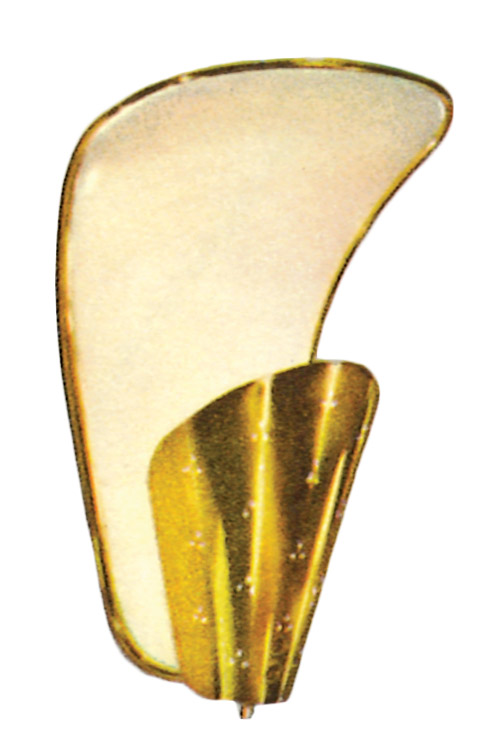
Mid-Century Modified, 1960-1965
Design DNA: Late-‘50s Modern liberally mixed with safer traditional styles to broaden appeal
Character: More colorful and eclectic, with both high Modern and low-brow ersatz design
Materials: Usual metals, plus fiberglass, plastics, ceramics, wood, and natural materials
Features: Modern with funky twists, strong colors, swag chains, tinted “optic” glass shades
Fueled By: Space race, new materials, full national embrace of modern design and living
Key Cultural Developments: Rise of the Space Age, beginning and end of Camelot, suburban ranch expansion
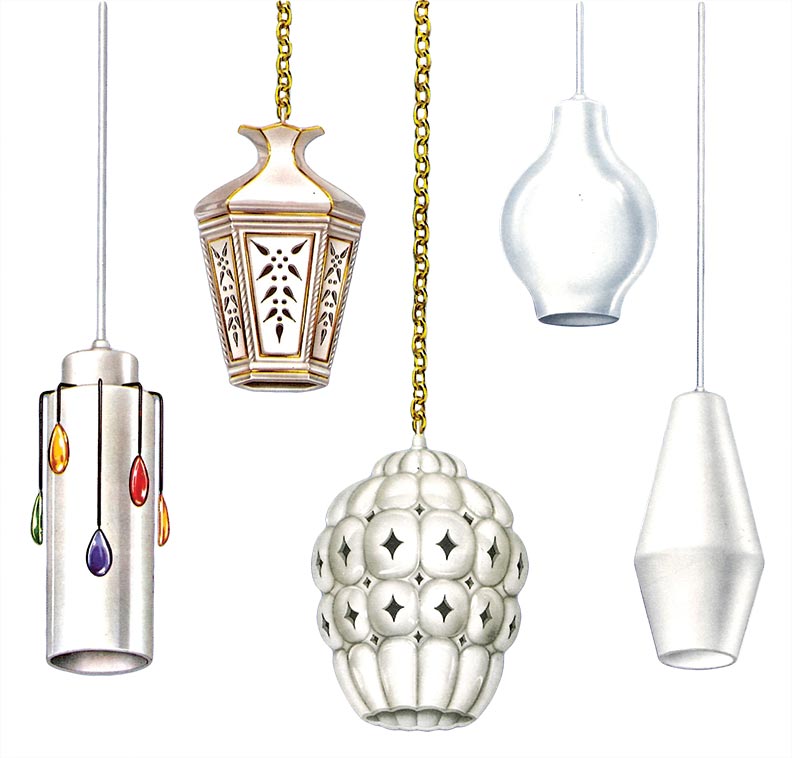
Mid-Century Contemporary
Design DNA: Italian, English and Scandinavian lighting designers lead Modernism forward
Character: Pure Modernism is infused with elegance and emotion
Materials: Fiberglass and plastic for Mod, chrome/brass and crystal for Contemporary
Features: Sculptural pipe/tube assemblies, bold colorful organic forms, smoky topaz glass
Fueled By: Earlier attempts to make high Modern accessible, resulting in more balanced mixes
Key Cultural Developments: Vietnam War/Civil Rights drive counter-culture revolution, free love, new ideas
